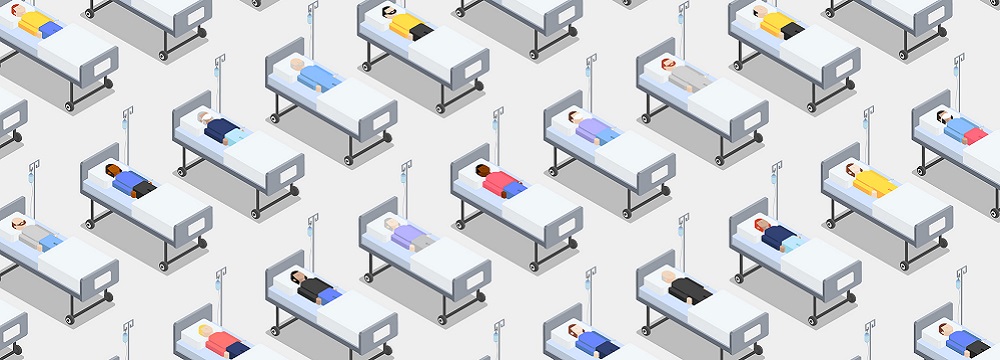
How much work is too much?
Researchers are working to identify the effects of heavy workload on hospitalists and their care.
There are many differences between being a hospitalist and being a resident or a nurse, of course, but for workload researchers, there's a particularly important one: patient caps.
“On June 30, you're taking care of the 10 patients that you get as a resident, and then on July 1, once you become an attending, the sky's the limit,” said Sarwat Chaudhry, MD, a professor of medicine and director of research for the program in hospital medicine at the Yale School of Medicine and Yale-New Haven Hospital in New Haven, Conn.
Registered nurses (RNs) have caps set not only by their hospitals, but in some places, such as California, by the government, noted Mona Al-Amin, PhD, associate professor of healthcare administration at Suffolk University in Boston. “Some states have mandated or are considering mandating minimum RN staffing levels,” she said.
The pandemic only intensified the issue of workload, said Mia Djulbegovic, MD, recalling her work as a hospitalist in spring 2020. “When I think back to that time, when I cared for a higher volume of patients than ever before, it just really highlighted how strained our system is and that we didn't have a solution for it. The solution was just to stretch the hospitalist as far as they could go.”
It seems obvious that putting this load on hospitalists could carry consequences for the physicians themselves, patients, and hospitals, but the project of identifying these effects and averting them is challenging and relatively nascent, according to researchers.
“Empirical research that gives us accurate findings is still scarce. I've been arguing for the past few years that we need to put as much emphasis on understanding what determines hospitalists' staffing levels as we spend on understanding what determines registered nurses' staffing levels,” said Dr. Al-Amin. “I think now we have all the right settings for research to go deeper into this.”
The latest research
Some of the latest evidence on hospitalist workload comes from a study by Drs. Chaudhry, Djulbegovic, and colleagues at Yale. It was motivated by the pressures and concerns physicians there felt even before the pandemic.
“We would talk about the days where we were only responsible for caring for 12 or 14 patients. We felt like the care we were giving those patients was so much better than on the days that we were taking care of 20 or more patients,” said Dr. Djulbegovic, a hospitalist clinician and researcher at the time, now a hematology/oncology fellow at the University of Pennsylvania in Philadelphia.
She and her colleagues decided to gather evidence to assess the accuracy of their anecdotal impressions. “Was it actually true that we gave inferior care or potentially kept patients in the hospital longer than necessary when we were responsible for more of them?” Dr. Djulbegovic asked.
The answer, published by the Journal of Hospital Medicine on June 6, was less than definitive. If a hospitalist had 16 patients on the day he or she admitted a patient, the patient's length of stay was 0.05 day longer than if the hospitalist had 13 patients, which was a statistically significant difference.
“There was a positive association between those two things, meaning that the number of patients that the hospitalist carried did affect length of stay,” said Dr. Djulbegovic. “But it was a very mild association.” The study also found that patients' risk of readmission did not appear to vary by their hospitalists' workload.
The observational study has many potential confounders, she noted. “When hospitalists take care of more patients, it's probably because there are more patients in the hospital. … You can imagine that when the hospital is full, the hospitalist is motivated to discharge patients sooner, so that turnover can happen.”
In addition, while the observed increase in length of stay may not matter much on the individual patient level, it will eventually add up, Dr. Chaudhry pointed out. “If you multiply that over hundreds and thousands of patients over the course of a month, quarter, year, for a busy hospital, it does start to make a difference,” she said.
The authors of another recent analysis of hospitalist workload encountered similar results and challenges. Their study, published as a research letter by JAMA Network Open on Jan. 20, compared outcomes of admitted Medicare patients by how many of them a hospitalist was handling at the time. Length of stay was a little longer when hospitalists were busy, but rates of readmission and mortality did not differ, and resource use was actually a little lower.
“We certainly weren't anticipating a lot of patient harm, but we anticipated that there might be some consequences, particularly for outcomes that seem like they might be dependent more on any individual's ability to manage their workload in any given day,” said lead author Jennifer P. Stevens, MD, MS, an assistant professor of medicine at Harvard and director of the Center for Healthcare Delivery Science at Beth Israel Deaconess Medical Center in Boston.
Again, the study design limited conclusions that could be drawn from the results. “It was solely done in Medicare patients, and the number of Medicare patients that you admit on a given day may not entirely reflect all the patients that you admit on a given day,” said Dr. Stevens.
Another challenge to identifying effects of workload is variation between hospitals. The study of Medicare patients used data from almost 1,000 hospitals.
“It's very institution-specific. What I do every day might be very different than what someone does across the street. … Our magic number might be different than someone else's, dependent on patient complexity, patients' social needs, other demands, service structure, and roles of ancillary or support staff,” said Ajay Bhasin, MD, an assistant professor of medicine and pediatrics at Northwestern Medicine in Chicago. “For us, 12 to 14 patients might be fine or might be too much, whereas elsewhere 16 to 18 may feel the same as our 12 to 14.”
Many characteristics could have an effect, from a hospital's size and level of team support to its contracts with hospitalists, according to Dr. Al-Amin. “The bigger the hospital, the more the complexity, the more responsibilities hospitalists have, because now they're dealing with many other departments, specialists, protocols, policies and so on,” she said.
Her research has shown that whether a hospital employs its hospitalists or they work under contract could also affect workload-related outcomes. Higher hospitalist staffing was associated with higher performance scores from CMS, but not if the hospitalists worked under individual contracts, according to results published in the February 2020 Health Services Research.
“The knowledge and understanding of a hospital's policies and processes, its culture, the patient population, are all different based on the contract, and I think that also has an impact on what should determine staffing levels,” said Dr. Al-Amin. She foresees a future point when researchers could account for hospital, patient, and hospitalist factors to determine a “magic staffing number” for each hospital or hospital medicine service.
“You can picture a table where if you're a major teaching hospital, that's your RN staffing level, and [if] you're located in an urban location, among other factors, this is the recommended number of hospitalists or number of patients per hospitalist,” Dr. Al-Amin said. “I think that is doable. … We're not close to being there yet.”
Perceptions of workload
One big factor not mentioned so far, or in most of the existing research on the topic, is the perspective of hospitalists on their workload. “If we trust hospitalists to take care of patients, we have to also trust them when they talk about the amount of patients they can take care of in a day,” said Dr. Al-Amin.
However, a recent study did ask hospitalists to talk about their workload. Dr. Bhasin and colleagues studied the effect of increasing the number of dedicated admitters from three to four during the late afternoon and early evening. “We had noted that during the admitting shifts, people were getting—for lack of a better term—crushed during this midday surge,” he said. “We were undergoing a staffing expansion, so we decided to study whether the presence of an extra admitter during a peak stress hour would translate to perceived change.”
To determine whether this intervention alleviated the crush, the researchers not only tallied the number of admissions each hospitalist handled but also surveyed them every weekday at 5 p.m. using the NASA Task Load Index, a validated survey that gauges workload across six domains. Results were published in the June 2020 Journal of General Internal Medicine.
They were pleased to find significant reductions in both admissions per hospitalist and work stress, including frustration, according to Dr. Bhasin. “If we saw an improvement in both absolute workload and how people perceived it, you can definitely directly tie how much work you're doing in a short time to how much stress you're feeling. If we didn't see a difference, maybe there are other factors contributing to work stress that need to be studied,” he said.
The stress on hospitalists themselves should be a key consideration in workload analysis, all the researchers agreed.
One potential conclusion of Dr. Stevens' study is “that hospitalists can rise to many challenges,” she said. “We cannot extend these findings to some of the extreme case burdens that physicians are having to face right now as they are covering for colleagues who might be out sick or are taking care of patients who have had to delay care for the past two years.”
Dr. Chaudhry offered similar thoughts when speculating about why her own research didn't show negative effects on patients of physicians with higher workloads. “Is this just the hospitalist hustling to make it work against all odds? But what's the price of that?” she said. “We don't measure things like fatigue.”
On-the-ground observation could potentially analyze such factors, according to Dr. Djulbegovic. “You may even be able to measure both subjective and potentially objective assessments of their fatigue, irritability, frustration, satisfaction. How much time do they spend with patients? Do they feel that they're providing safe and effective care? How do the patients feel about the care that they're receiving?”
If the answers to these questions reveal impacts on patients' or physicians' feelings, it could give hospital administrators more reason to care about workload. “There could be potential return on that investment in hiring more hospitalists upfront to decompress the workload,” Dr. Djulbegovic said. “A balanced workload that allows clinicians to stay in the workforce longer could reduce turnover, which has huge costs.”
Allowing hospitalists time to work on hospitals' quality and efficiency is critical as well, noted Dr. Al-Amin. “They are the ones who might help us improve processes of care. We want them not to just deliver patient care. We want them to also be able to see the bigger picture and improvement opportunities.”
Given their firsthand knowledge of their own workload, Dr. Al-Amin encourages hospitalists to talk about these issues with researchers and leaders. “We need to hear from them, too. It cannot just be us looking at numbers,” she said.
Dr. Chaudhry hopes that the data she and other researchers have been able to provide so far will help spur that involvement. “The best thing that could come out of this is if our study really inspires more conversations, more analysis, more study,” she said. “As hospitals have gotten busier and busier and hospitalists' workloads have gotten higher and higher, there hasn't really been a lot of discussion. … People need reasonable caps on their workload.”



